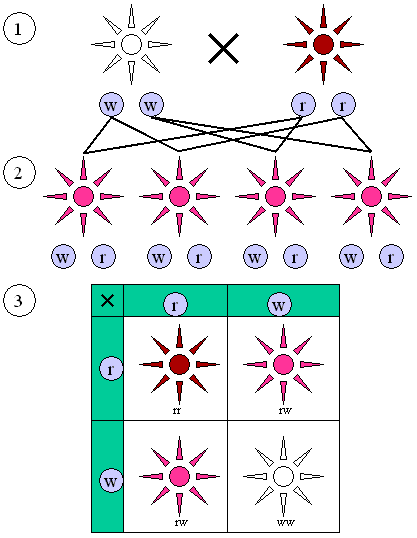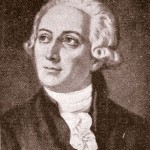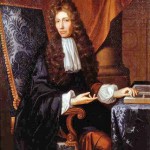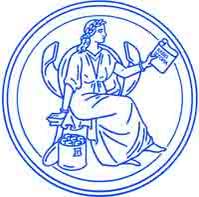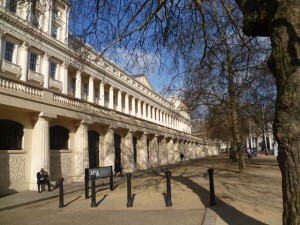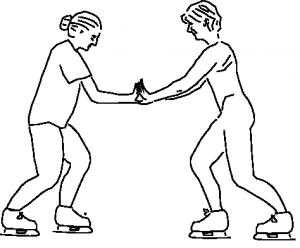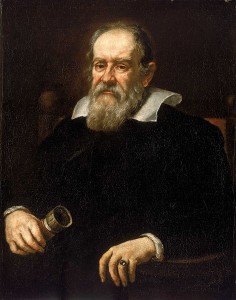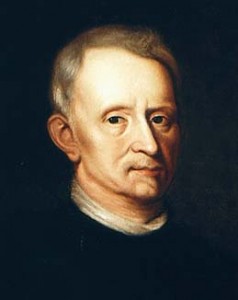Isaac Newton

Isaac Newton
by Sir Godfrey Kneller, used under ![]()
Isaac Newton was born on December 25, 1642 in England. He attended Trinity College at Cambridge University and earned a masters degree in mathematics in 1669. After graduation, he because a professor for the university for twenty-seven years. Newton was an absent-minded professor, sometimes forgetting to do routine tasks like eating and sleeping (Karwatka 2011). This behavior was a result of his dedication to his scientific work. His mind was always pondering why things were how they were and what could be done to figure out the reasons why.

Isaac Newton’s Prism Light Experiment
by Matthew Surrence, used under ![]()
Newton’s first scientific work regarded optics. He observed sunlight shining onto a prism and saw that the clear, white sunlight broke into colors of the rainbow. He then put the refracted light from the first prism through a second prism, which resulted in the colored light going back to white (Karwatka 2011). He proved that white light is not homogeneous and simple, but is really heterogeneous and complex. It is a mixture of many different light rays (or colors), which each have their own wavelengths. Each type of ray/color refracted through the first prism at a different angle dependent upon their wavelength (Shuster, 1997). These different wavelengths were all present in the white sunlight, but they were each refracted differently through the first prism, producing the different colors because they were now all separated from each other. When they were all refracted again through the second prism, they were converged, at the same angle, back to white light.
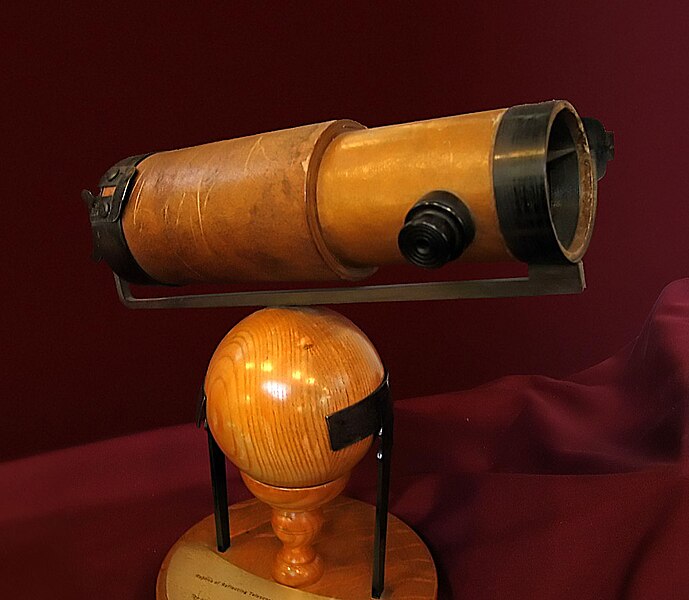
A replica of Newton’s second reflecting telescope of 1672
by Andrew Dunn, used under ![]()
This discovery led Newton to develop the first reflecting telescope in 1668. Before this invention, scientists were just able to make fuzzy observations of the sky with glass lens, refracting telescope (Karwatka 2011). Newton’s telescope made these observations much more clear and magnified. He carved a mirror into a small bowl shape and placed it at the bottom of a 1.3 inch-diameter paper tube. He then viewed planets with an eyepiece on the side of the tube and another mirror in the tube. This gave him thirty to forty times magnification (Karwatka 2011). The two mirror idea was completely new and revolutionary. Light enters a reflecting telescope from the top, travels to the bottom of the tube, and hits the curved mirror. The curved mirror reflects the light to the mirror right below the eyepiece, which reflects the light up through the eyepiece where people can view it. Reflecting telescopes are still in use today with the largest one having a 410 inch diameter and residing in the Canary Islands (Karwatka 2011). Newton’s advancements in optics boosted the science of astronomy and led to many other discoveries.

Newton’s Law of Universal Gravitation
by Dennis Nilsson, used under 
Isaac Newton’s most revolutionary work was his work in physics and gravitation. Newton published his Publication of Philosophiae Naturalis Principia Mathematica in 1687 (Newton’s Solitary Genius 1996). This paper contained Newton’s theory of universal gravitation and his three laws of motion. The theory of universal gravitation states that every particle of matter in the universe attracts every other particle with a force that equals the sum of both particles’ masses divided by the distance between them squared (Sir Isaac Newton 2014). This discovery led Newton to form revolutionary ideas about celestial bodies in the Milky Way. He deduced that gravity is the main force controlling the motions of celestial bodies. He also stated that Earth’s gravity extended to the moon, counteracting the moon’s centrifugal force, which is the force drawing a rotating body away from the center of rotation (Shuster, 1997). These discoveries have been further proven today and are significant to today’s view of the solar system and world in general.

Saturn 5 Rocket that Newton’s calculations allowed to reach the moon
by NASA, used under ![]()
Newton’s three laws of motion also were in his Principia. Newton’s first law states that “every object in a state of uniform motion tends to remain in that state of motion unless an external force is applied to it” (Newton’s Three Laws of Motion). This law is also known as the Law of Inertia. It means that an object at rest will stay at rest, or an object in motion will stay in motion unless acted on by an outside force. Newton’s second law states that “the relationship between an object’s mass m, its acceleration a, and the applied force F is F = ma. Acceleration and force are vectors; in this law the direction of the force vector is the same as the direction of the acceleration vector” (Newton’s Three Laws of Motion). The formula shows how velocity changes (acceleration) when a force is applied, which is significant. Newton’s third law states that “for every action there is an equal and opposite reaction” (Newton’s Three Laws of Motion). This law is shone when a person steps onto a dock from a small boat on a body of water. The person propels himself towards the dock while pushing the boat away from the dock. His push-off from the boat moves the boat backward and him forward. Newton’s three laws are fundamental truths in basic physics today and are accepted worldwide. As a matter of fact, Newton’s Principia is considered the best scientific work ever written, and it was the basis for the flight path of the Saturn 5 rocket that first took Americans to the moon in 1969 (Karwatka 2011).

Tangent Line
by Orderinchaos, used under ![]()
Another spectacular accomplishment of Isaac Newton was his invention of calculus. He invented calculus in order to help him calculate some of his formulas and theories in his Principia. He developed ways to find tangents to curves (differentiation) and to find areas bounded by curves (integration) (Hall, 1998). Calculus is studied in schools worldwide, including most American high schools and all American universities. It allows engineers and mathematicians to find precise answers needed for construction, transportation, and other feats.
Isaac Newton died in 1727 and is buried inside London’s Westminster Abbey (Karwatka 2011). Most of his discoveries were accepted widely by the time of his death, and he was regarded and treated like the genius he was for the most part. He is regarded as the main contributor to modern physical science and one of the brightest people to ever live.
Works Cited (Text)
Hall, A. R. (1998). Isaac Newton’s Life. Retrieved April 4, 2014, from Isaac Newton Institute for Mathematical Sciences: https://www.newton.ac.uk/newtlife.html
Karwatka, D. (2011). Isaac Newton and His Scientific Discoveries. Tech Directions, 70(8), 10-11.
Newton’s solitary genius. (1996). Wilson Quarterly, 20(2), 136.
Newton’s Three Laws of Motion. (n.d.). Retrieved April 4, 2014, from University of Tennessee, Knoxville: http://csep10.phys.utk.edu/astr161/lect/history/newton3laws.html.
Shuster, J. A. (1997, October 30). Sir Isaac Newton. Retrieved April 4, 2014, from Michigan Technological University Chemistry : http://chemistry.mtu.edu/~pcharles/SCIHISTORY/Newton.html.
Sir Isaac Newton. (2014). Encyclopedia Britannica. Retrieved from http://www.britannica.com/EBchecked/topic/413189/Sir-Isaac-Newton/12246/Influence-of-the-scientific-revolution. (Newton’s Three Laws of Motion).
Works Cited Pictures
Surrence, M. Newton’s Prism Light Experiment. [Digital Image]. Retrieved from: http://blog.zennioptical.com/prism-correction/. Attribution-ShareAlike.
Kneller, G. Isaac Newton. [Digital Image]. Retrieved from: http://en.wikipedia.org/wiki/File:GodfreyKneller-IsaacNewton-1689.jpg. Public Domain.
Dunn, A. Isaac Newton’s Second Reflecting Telescope. [Digital Image]. Retrieved from: http://en.wikipedia.org/wiki/File:NewtonsTelescopeReplica.jpg. Attribution-ShareAlike.
Nilsson, D. Isaac Newton’s Law of Universal Gravitation. [Digital Image]. Retrieved from: http://en.wikipedia.org/wiki/File:NewtonsLawOfUniversalGravitation.svg. Attribution.
NASA. Saturn 5 Rocket. [Digital Image]. Retrieved from: http://en.wikipedia.org/wiki/File:Apollo_17_The_Last_Moon_Shot_Edit1.jpg. Public Domain.
Orderinchaos. Tangent Line. [Digital Image]. Retrieved from: http://simple.wikipedia.org/wiki/File:Simple_curve_showing_tangents.svg. Public Domain.
Erik Krol

